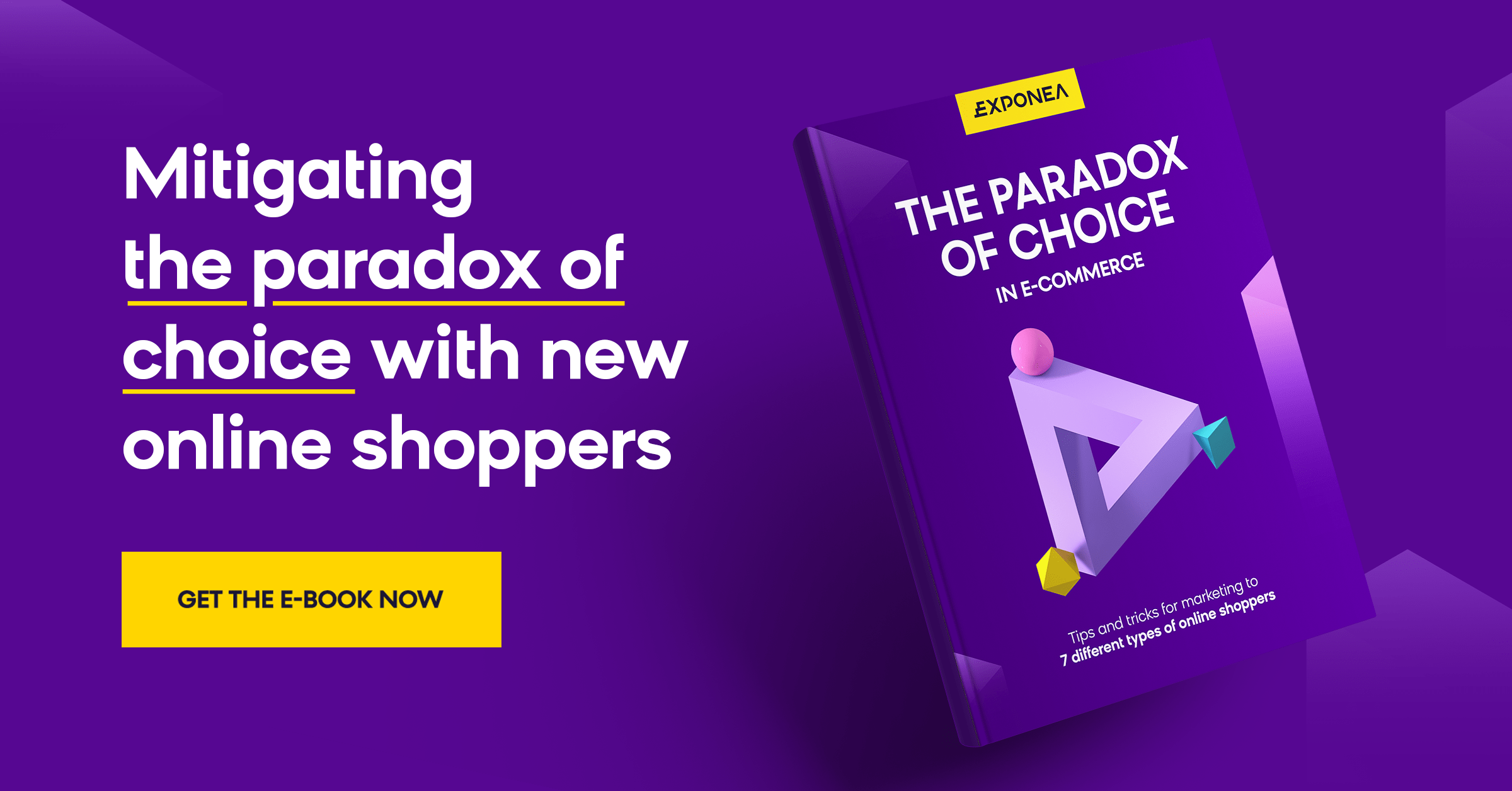Have you ever walked into a restaurant, looked at a multiple-page menu with seemingly endless options, and been totally overwhelmed? Many people have, don’t worry.
In this situation, we usually ask those with us what they might be ordering, ask the server for a recommendation, or just order what you generally order at most restaurants because of the pressure of making a decision in a short timeframe.
This is one of many examples of how the paradox of choice affects us in our everyday lives. The paradox of choice holds a similar definition to the term “overchoice” or “choice overload”. It simply means that people have a difficult time making a decision when they are given either too many or too few options.
For humans to be happiest, we need the correct amount of choice associated with decisions. Having no choices can leave us despondent and feeling the need for more freedom. Having too many choices forces us to make a tougher decision and can potentially leave the decision maker with a “buyer’s remorse” type feeling.
This is crucial when it comes to e-commerce strategies. Especially now.
With the unforeseen health crisis impacting every corner of the globe in 2020, shoppers have logged on to the websites of online retailers for their clothing needs rather than racing to their local brick-and-mortar stores as they have in the past.
This has caused the online retail clothing industry to boom in 2020.
While that’s reason for celebration amongst online retailers, a smart company is always taking the necessary steps to be ahead of the game.
What will the online retail clothing industry look like when the challenges of 2020 are behind us? What might help us in painting a picture of the future is simple: an assessment of human behavior in 2020.
Human behavior is largely dependent on context, so whatever context becomes the default moving forward will be a significant driver of future behavior. Consumers have been forced to change their habits, which are the preferred operating state of human beings because they involve very little cognitive effort. The default behaviors they’ve had previously have been disrupted.
The longer the changes of 2020 persist, the longer the behavioral shifts will continue and the longer things might take to shift back, if they shift back at all. That means your business should take a proactive approach to serving new customers acquired in 2020 rather than a reactive one.
Identifying particular trends to continue working on will allow brands across the world to continue serving these new buyers. Understanding overchoice, or the paradox of choice, and how it affects customers shopping for clothes online is an important one of those trends.
Table of Contents
The paradox of choice in online fashion retail
Making a decision can feel completely overwhelming when all of the potential outcomes/risks are considered, particularly those that stem from making the wrong choice. Having too many good options can be frustrating as well because each option must be analyzed against the others to help determine which is best. Hence, one of the ultimate struggles for online retailers: finding the correct balance of having the appropriate amount of products for customers to choose from compared to overwhelming people with things to buy.
As the world has seen shopping habits change due to the unforeseen circumstances of 2020, this should be a major consideration for e-commerce fashion retailers moving forward.
With all sorts of new types of shoppers online (more on that later), how can your online retail shop help these new potential customers to not feel paralyzed by the wide variety of options that are now at their fingertips on your website?
To understand how to best serve your e-commerce customers, you must first have an understanding of who these people are and how they behave.
While it is impossible to have that information for each individual browsing your website, having a general idea of the population you are serving is essential to appropriately serving that population.
Philip Graves is a consumer behavior consultant and author of the book Consumer.ology, The Market Research Myth, The Truth About Consumers and The Psychology of Shopping. In collaboration with Graves, Exponea commissioned a behavioral analysis study to understand more about the shoppers who have made the shift from shopping at brick-and-mortar stores to shopping online during 2020.
“From a behavioral economics point of view, we know there has been a big behavioral shift,” Graves said. “What we set out to understand was why and what was going on with it.”
So let’s send out a survey to 1,000 shoppers and analyze the data, right?
Not so fast.
According to Consumer.ology, people are extremely bad at understanding their own decision making and behavior. In a sense, they do not know themselves. Therefore surveying shoppers on their thoughts on e-commerce during a global pandemic would not produce useful results.
“Most research is obsessed with statistical validity,” Graves said. “What it completely abandons is psychological validity. To what extent are people capable of answering the questions being asked? Oftentimes, they aren’t qualified to answer the questions because they don’t understand their own behavior.”
What would be an appropriate way to analyze current trends? A behavioral analysis. Research that is completely uninfluenced and totally reflective of the behavioral changes seen in 2020.
So that’s what we did. The shopping behavior of people (both male and female) of different ages and socioeconomic backgrounds living in different regions of the United States was analyzed. These were people who did little-to-no shopping online prior to 2020 in the United States and have since changed their shopping habits.

The results? Eye-opening, to say the least.
Behavioral insights
Avoid age segmentation
The sample of shoppers consisted of two age cohorts: 22-to-38 years old and 39-to-59 years old.
Despite the vast differences in the ages of some of the participants, there was no evidence that behavioral or psychological patterns were distinguishable by age. Even factors such as confidence in website usage, the returns process, and interaction with social media did not directly correlate with the shoppers’ age.
This is in part likely due to the fact that a lot of online shopping behavior is underpinned by psychological desires which are established in early development, before people become consumers as adults.
Based on the study, age is not a good way to segment these shoppers (people who are new to buying clothing online). Instead, it’s their behavior and underlying psychological desires that distinguish them from other people and each other.
Four key drivers for purchasing online
The research identified four key changes that pushed the people whose behavior was analyzed to online retail clothing shopping in the latter parts of 2020.
Contextual necessity
Many brick-and-mortar stores were closed, which left shoppers with no option but to shop online if they ‘needed’ clothes. This is an obvious reason to shift your shopping online.
Cost vs reward tradeoff
Even though many brick-and-mortar stores are back open, the cost-reward tradeoff has changed. It is oftentimes now less favorable for the in-person shopper.
Unforeseen restrictions of 2020 have increased the hassle of shopping in-store. Longer waits, one-way systems, the inability to try on items, and health-protective measures have all detracted from the in-store shopping experience.
In addition, many of the rewarding aspects of in-store shopping are now less feasible, such as visiting multiple stores, socializing, eating and drinking in-between shopping, and trying on different outfits.
When framed against the increased ‘cost’ and decreased ‘pleasure’ of in-store shopping, the attraction of online shopping has increased, some would say substantially.
Safety
Many shoppers are understandably more fearful of contracting or passing germs. Because of this, they shop online to minimize their exposure to others. Since stores were initially closed during lockdown, people tend to associate them with a high risk of infection. As a result, many shoppers now have the thought to avoid stores as much as possible.
Home centric
People are spending more time at home due to restrictions (e.g. they’re working from home, not out socializing as much) so they are less likely to find themselves in the vicinity of stores.
As a result, in-store shopping isn’t as salient and visiting a store requires a specific journey – it’s less likely to occur opportunistically.
Five shifts in shopping behavior
Where specifically are the changes in shopping behavior taking place now that this group of buyers is purchasing online? There were five main shifts found by the research.
The change in circumstances has driven some purchase behavior
Shopping has always been largely about needs and wants. The pandemic has greatly changed the needs of many.
With people going into the office less, the need for workwear has been reduced, and the need for comfortable clothes to wear around the house has increased. The desire for clothes to wear on a night out on the town has decreased as well as people are not out socializing as much.
There has also been an increase in “activity-based” purchases. For example, there has been an increase in purchasing walking/running shoes because that has become a safe way to exercise and get out of the house.
From a leisure activity to something need-based
The threshold for shopping has, for many, moved from a leisure activity to something much more needs-based, both online and in-store.
For online shoppers, this is particularly true for those who don’t receive the same pleasure from online shopping as they did in-store, but it also affects how a shopping “trip” is triggered. There needs to be a more specific item in mind to initiate the online journey, whereas previously, going out to the shops was sufficient.
In-store inspiration is no longer a trigger to purchase
If a shopper does not have his or her senses immersed in all of the aspects of the in-person brick-and-mortar store, the inspiration to make a spur-of-the-moment purchase may not strike.
In general, triggers to make a purchase are different. For “window shoppers” who would often buy what they saw in-store (e.g. window displays, what others were buying, item displays), that trigger is tough to replace.
Social media influencers are a powerful source of inspiration online
One way to replace that aforementioned trigger is with a social media influencer or something of the sort.
Social media influencers have become a source of inspiration and an influential driver of desire online. They are particularly impactful for people who were previously influenced by store displays, store employees, and what they saw other people wearing and buying.
Misattribution of excitement (from an event) has been lost
When people had more going-out occasions, the excitement of an upcoming event was often misattributed to the shopping trip. Buying an outfit was an extension of the event. However, without the events taking place, this trigger for purchase has disappeared.
Why the paradox of choice is exacerbated in e-commerce
No matter how familiar they are with online shopping, shoppers recognize that there are way more options in just about all aspects of online shopping. They have access to more retailers as they are not limited by store proximity, and access to more items as those retailers are not restricted by physical space.
This can certainly be advantageous as it increases the chance of customers finding an item that appeals to them and is in stock.
However, a massive amount of choices is not always optimal. If consumers are not able to manage the variety of options available, they can begin to feel overwhelmed and encounter a point of friction when purchasing online. That, in a nutshell, is the paradox of choice.
The behavioral analysis found several coping mechanisms shoppers were using to overcome these points of friction:
- Recommendations from trusted sources – This helps focus the attention and provide reassurance about the quality and desirability of an item.
- Using Google – Searching for specific items can direct attention to relevant web pages. The more specific the search is, the more effective this technique can be.
- Search and filter functions within a website – This is super helpful in narrowing down and ordering the options displayed. If the proper search language is used here, this tool can be very effective.
- Sticking with what is known – Shopping with brands or retailers that are familiar also helps to manage the amount of choices out there and provide reassurance to shoppers.
- Save for later – Keep your shopping journey focused by using this tool. See something you like? Add it to a wish list or online cart for later. Then go through this refined list of options when done browsing and select as you please.
Utilizing these techniques allows shoppers to find what they are looking for and have a better appreciation for the amount of choice that online shopping provides. Consumers who have not yet mastered these techniques are the ones who can become overwhelmed and perceive in-store shopping to be the solution to their problem.
A company creating other coping strategies for the paradox of choice or encouraging customers to use the aforementioned ones would allow it to retain customers at an advanced level.
Three ways Exponea helps alleviate the paradox of choice
Exponea is the ally you want on your team helping you to retain these customers and ensure that they are not overwhelmed by overchoice.
Exponea’s Customer Data & Experience Platform allows you to compile your data into one unified source and have a single customer view of individual customers. This is the basis for the amazing capabilities that Exponea offers your brand.
Exponea can help you retain your new customers in dozens of ways, but the three below directly relate to helping your newbies overcome paradox of choice issues.
Segmentation and Email Campaigns
Exponea allows you to send personalized email campaigns to specific customers to best market a product or group of products.
What does that mean for you in regards to the paradox of choice? You can group customers by date of their first interaction with your company and craft campaign emails to them with the tips you’ve learned from the behavior analysis in mind.
Perhaps your newsletter email gives a tutorial of the search and filter function on your website so customers can best navigate their way to the products they want to find. Or your campaign email highlights sale items that come with a recommendation from a trusted source.
However you decide to approach this, Exponea allows you to build these campaigns in a very user-friendly way that involves minimal time on your end.
On-Site Recommendations
Exponea’s on-site recommendations tool is perfect for mitigating the paradox of choice with newer customers.
The tool uses customer and catalog data to find the most applicable items to advertise to customers when they are on your website. This means using past behavior to make relevant recommendations to drive future purchases.
Using this specific data helps narrow down the choices of potential products to look through and ensures that the products seen by the customer are relevant. Exponea makes it easy to target individual customers with products on your website that history tells us will interest them.
What better way to retain a customer than presenting your most relevant products right away?
Abandoned Cart Campaign
Your purchase saver!
A customer has abandoned his or her cart online, perhaps struck by overchoice or just distracted by the myriad of things that can come up during the checkout process.
Exponea’s cart abandonment tool allows retailers to send an automated email to customers who have abandoned their carts to remind them to come back and complete their purchase. The tool is easy to use and is designed to help retain customers who just did not take that final step towards the purchase. It makes sure your company gets its hard-earned revenue.
Getting a reminder via email of the items they wanted earlier lets customers circle back to make the purchase with just a few clicks. This allows them to avoid having to make the amount of choices they made previously on your website and they can get straight back to what they know they are ready to buy.
Meet today’s shoppers
Keeping the shifting landscape of 2020 in mind, let’s go one step further.
Remember, all consumers in the study were drawn into online shopping mostly out of necessity. While they all entered the e-commerce space for a similar reason (to buy clothes), their reactions and behavior varied considerably after shopping online.
That data was compiled and used to make seven different shopper types that can be categorized into two groups: those that primarily want to get back to in-store shopping, and those that are fully converted to online.
It’s important to remember that the sample for this research was people who only very occasionally (or never) shopped for clothes online, but have recently begun to purchase through this channel.
Clearly, the e-commerce market consists of many people who are already accustomed to shopping for clothes online. However, there is an opportunity for e-commerce retailers in understanding this new audience.
Your company should make every effort to retain this audience by understanding who comprises it and how best to serve them. Specifically, how online fashion retailers continue to market and appeal to these shopper types will dictate how many of these audience members will remain online shoppers in the years to come.
It is also important to reiterate that this is a qualitative exercise. This is not an attempt to quantify these shopper types, but instead highlight the different ways in which consumers are reacting to contextual changes and shifting their thinking as a result.
These insights should provide a useful framework against which retailers can reference their (quantitative) data to estimate how many of each shopper type they have and to understand the patterns they observe in that data.
The ‘take me back to the store’ shoppers
WHAT SHOULD YOU READ NEXT? AUTHOR’S HAND-PICKED RECOMMENDATION:
The Sensory Shopper
Who is this shopper? This shopper enjoys seeing and touching the clothes he or she is buying. This is an important part of the shopping experience. They enjoy trying items on and have much less certainty about making a purchase if they cannot do the aforementioned things.
How is this shopper affected by the paradox of choice? This shopper is already feeling down about not being able to touch or feel the material of the clothing, he or she could very easily become overwhelmed by the sheer amount of options from a generic search, such as “white top”. Providing this shopper with detailed information about the search/filter function will assist the product search process.
How can Exponea help keep this shopper online? To avoid this shopper type feeling a high sense of loss aversion while shopping online, focus on making the experience as accommodating as possible. This could be done by using Exponea’s “Free Delivery Banner” Plug&Play use case or by pushing reassuring information to the customer via an Exponea weblayer. Your company can also push out videos or images that show someone handling the fabric via an email campaign to customers who fall into this segment.
The Leisure Shopper
Who is this shopper? This person enjoys shopping not only for the end result of a new purchase, but also for the experience involved. This type of shopper will often do a lot of browsing to garner the complete experience of shopping before selecting an item or multiple items. Shopping is not simply transactional for this shopper type, the “buzz” surrounding the purchase is very important.
How is this shopper affected by the paradox of choice? While this person is capable of heavily browsing in person, online item browsing can cause product fatigue much more quickly. Individuals in this shopper type will do considerably less browsing online, which means your brand’s on-site recommendations need to be good to connect with this shopper.
How can Exponea help keep this shopper online? Exponea’s “Social Proof Banner” Plug&Play use case is perfect for creating more buzz around the items that this shopper is considering. It will display a message such as “X customers are looking at this” to help patrons feel reassured about making the purchase. Additionally, Exponea’s customizable email campaigns allow you to spruce up your emails to individuals in this shopper type so they can feel the fanfare involved with online shopping as well. Don’t forget to include items “recommended for you” in those campaigns so this shopper type feels that special personal connection to your brand.
The ‘Clothes for Status’ Shopper
Who is this shopper? Folks in this shopper type use clothing to demonstrate and elevate their status and place an extensive importance on the way they look and dress. They enjoy the “ceremony” of shopping and believe there is a sense of status associated with the brands they choose to support. Because these shoppers are concerned by the way they look, they are inclined to search for style inspiration and get pleasure from believing that what they are wearing looks good.
How is this shopper affected by the paradox of choice? Individuals in this shopper type are more prone to use a brick-and-mortar store employee to assist them in choosing clothes in-person. They are also more likely to keep a close eye on what others in the store are purchasing to help them reduce the amount of items they need to mentally sort through. This helps notify others of their status while shopping. Since this is not an option online, the website design and search/filter functionality is extremely important for people in this shopper type.
How can Exponea help keep this shopper online? Adding a personal touch to replicate the sense of status as much as possible is key for this group. Exponea allows you to do this in a multitude of ways. The COVID-19 Social Proof Banner is the perfect Plug&Play use case for this shopper type because it will detail the amount a particular item has been purchased since people in this group have shifted to becoming online shoppers. Additionally, the Bi-Weekly Automated Top Product Newsletter Plug&Play use case would be a great fit for this demographic as well. This use case allows businesses to send an email every 14 days showing top product recommendations and a banner detailing how many times they were bought. This will help a shopper in this group elevate his or her sense of status in relation to the products in the email.
The Perfectionist
Who is this shopper? Members of this shopper type desire everything they buy to be perfect. They want everything purchased to look, feel, and fit perfectly. Because of this, they are very concerned with return policies and the potential negative feelings associated with that process. They are also very likely to listen to advice from friends or other trusted sources.
How is this shopper affected by the paradox of choice? Since perfectionism is at hand here, buyer’s remorse can be an issue for this group. This, of course, is a negative side effect of overchoice when you are faced with deciding between multiple products you like and are not totally certain about your purchase because of the effects of the paradox of choice. Providing easy access to product reviews will help this group of shoppers feel better about the selection process.
How can Exponea help keep this shopper online? Two Plug&Play use cases from Exponea fit this customer type very well. First, the Global Badges use case would allow your company to advertise its return policy on the product image to ease the concern of these perfectionists. Exponea’s Automated Newsletter for New Items from Most Visited Plug&Play use case would be a great fit here as well. This use case takes the most commonly viewed category for each customer (for which a purchase has not yet been made) and uses a webhook to show the new items from the catalog in that category in an email. If a member of this group just could not get past the browsing stage because he or she did not think the item was perfect, this specifically-targeted email might help this individual to reframe that thinking.
The ‘convert to online’ shoppers
The ‘Desire to Save’ Shopper
Who is this shopper? Shoppers in this profile are heavily influenced by price. They are drawn to discounts and sales and get a feeling of satisfaction from the feeling that they got a deal on a product. Online shopping suits them well because there is a larger range of items available so there’s a higher chance of finding a deal they can get excited about.
How is this shopper affected by the paradox of choice? Paradox of choice is less detrimental to this type of shopper because he or she likely isn’t purchasing many full-priced items. The sale items are where these shoppers keep their focus. That organically trims the list of potential products to purchase for this shopper and keeps him or her less saturated by overchoice.
How can Exponea help keep this shopper online? Exponea’s vouchers tool is perfect for these shoppers. The vouchers tool allows companies to create discount codes, distribute them to customers through email, and track how quickly customers redeem the code. This is ideal for shoppers who are looking for a great deal. Sending these shoppers additional time-sensitive vouchers through their email can also create a sense of urgency amongst them with the feeling that they don’t want to waste the outstanding discount they have received via email.
The ‘Fashion Follower’ Shopper
Who is this shopper? This shopper type is concerned with looking good and keeping up with all of the latest fashion trends. Individuals who fit this mold get pleasure from purchasing products that align with this. This group values the convenience and flexibility offered by online shopping and the fact that they can access the latest trends faster online.
How is this shopper affected by the paradox of choice? This group loves the input of social media influencers. Why is that great for overchoice concerns? This group will often use your brand’s search/filter function to shop in a very targeted way for items they know they love because of what they’ve seen on social media. While other shoppers might search for “black pants” and be overwhelmed by the amount of search results, this group is far more likely to tailor searches to specific products that are highly trendy or that they saw on social media.
How can Exponea help keep this shopper online? Exponea’s Automated Instagram Content Newsletters Plug&Play use case fits this group well. This automation automatically checks the latest posts from your brand’s Instagram feed and sends them to customers for inspiration. This ensures this group, which loves social media, is aware of what your company is posting and can engage with that content via email as well as social media. Exponea’s Integrations will also allow you to retarget relevant ads to customers on social media sites in a highly intentional manner.
The ‘Happier Online’ Shopper
Who is this shopper? This group gets a great deal of enjoyment from shopping and uses the activity to feel good. The act of purchasing clothes releases positive feelings in the brain which reinforces the behavior. Online shopping now gives this group the opportunity to achieve these feelings from home at any time. Members of this group even view waiting for items to be delivered as an exciting factor of online shopping rather than a drawback.
How is this shopper affected by the paradox of choice? Shoppers who fit this profile are uniquely prepared to handle the paradox of choice with online retail shopping. While it is certainly impossible for them to experience the feeling, the positive feelings that come from the shopping process (browsing, purchasing, delivery, etc.) greatly outweigh any negative feelings that might stem from product overchoice.
How can Exponea help keep this shopper online? This is the dream shopper to market to with Exponea. There are dozens of tools in the Exponea platform that can help you turn people in this shopper profile into your most loyal customers. Exponea’s Loyalty Program Plug&Play use case is the perfect retention tool to keep the good vibes going with this group. The use case will allow you to assign loyalty tiers based on a customer’s purchase behavior, email engagement, and browsing history. A “congratulations”email will be sent once a customer reaches a higher tier. That email would of course include incentives for the next purchase or other rewards. Making members of this group a part of your loyalty program will help you keep them happy and keep them coming back for more.
Exponea holds your ticket to new customer retention
Imagine you’re spending a lovely day at the local swimming pool, dipping your toes in the water, and trying to decide if you’d like to get in.
All of a sudden, a strong gust of wind causes you to lose your balance and you land straight in the deep end of the pool.
What might you be feeling at that moment? A bit of shock, a bit of excitement, a bit of panic, all at the same time.
Brick-and-mortar shoppers across the world were “pushed into the pool” of shopping online during 2020. They shared all those feelings that you were experiencing in the deep end of the pool as they were browsing through your website searching for the items they needed.
These new customers now have to decide if they like the pool water and want to spend some time swimming, or if they want to get out of the pool as fast as possible and complain to their friends about their experience.
What is your business doing to retain as many swimmers as possible? In other words, what is being done to ensure that online shoppers who are currently interacting with your brand are receiving the best possible customer experience? Now is the time to be intentional about retaining these customers so they will remain loyal to your brand for years to come.
More importantly, who is on your team and helping your company in these efforts? Exponea’s world-renowned Customer Data & Experience Platform provides a single customer view that makes producing elite customer service experiences second nature.
Exponea gives you all the tools you need to transform your customer data into top-performing campaigns and content. The flexibility Exponea provides allows you to act on your data in almost any way imaginable.
This additional knowledge you’ve gained about your customers should not go to waste. Schedule a demo today with Exponea to see how you can take the next steps in organizing and collecting your data in a way that allows you to retain your new customers and take your brand to the next level.
WHAT SHOULD YOU READ NEXT? AUTHOR'S HAND-PICKED RECOMMENDATION:
The Ultimate E-Commerce Guide to Marketing Psychology
Improve your most important metrics while creating a better customer experience using our list of 10 research-backed tips.




 Blog
Blog











